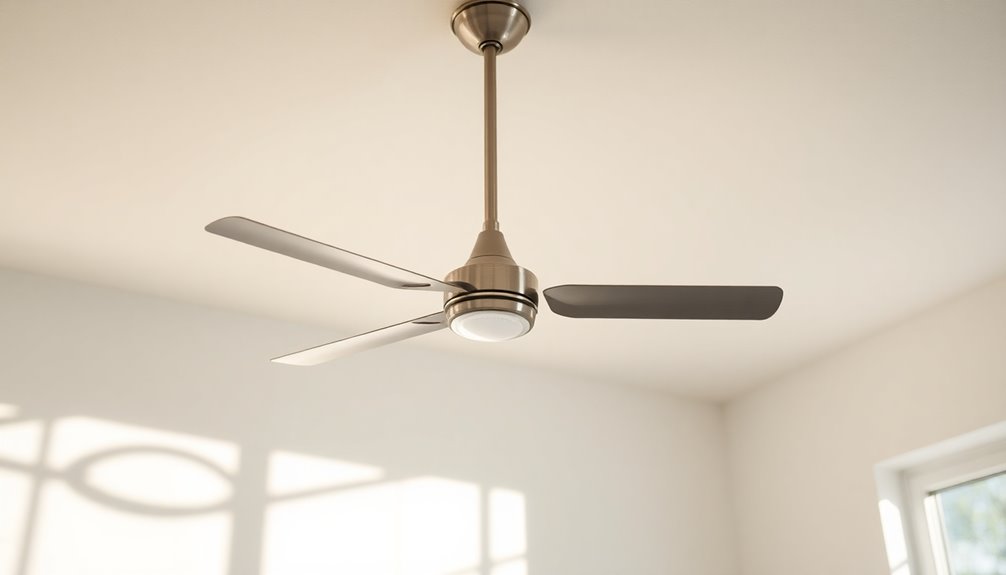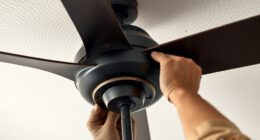Ceiling fan sizes are primarily measured by the blade span, which is the distance from tip to tip of the blades. To get this measurement, you simply measure across the widest point of the blades. If your fan has an odd number of blades, double the distance from the center to a blade tip. Recommended sizes vary based on room size: up to 36 inches for small rooms and up to 60 inches for larger spaces. Remember, ensuring proper installation height and clearance can enhance airflow even more. Stick around to discover additional insights on selecting and installing your fan.
Key Takeaways
- Ceiling fan size is measured by the blade span, which is the distance from tip to tip of the blades.
- For even-bladed fans, measure the full length from one tip to the other; for odd-bladed fans, double the center measurement.
- Recommended fan sizes vary based on room size, ranging from 29-36 inches for small rooms to 50-60 inches for larger spaces.
- Ensure at least 30 inches of clearance between the fan blades and walls for optimal airflow and circulation.
- Measure ceiling height to determine the appropriate downrod length for effective fan installation and airflow efficiency.
Measuring Room Dimensions

To measure your room dimensions accurately, grab a tape measure and start by finding the length and width in feet. Position one end of the tape against one wall and stretch it to the opposite wall, ensuring you're measuring straight across.
Once you have both measurements, calculate the square footage by multiplying the length by the width. For instance, if your room measures 12 feet by 15 feet, you'll get 180 square feet.
If you're dealing with an L-shaped room, divide the space into two rectangles, measure each section's length and width, and then sum their square footage for the total.
Don't forget to take into account ceiling height when selecting your ceiling fan size, as this can impact airflow. Additionally, keep an eye out for any obstructions like furniture or beams that could disrupt airflow and affect the fan's efficiency.
Calculating Room Square Footage

Calculating room square footage is a straightforward process that starts with the measurements you've taken. First, you need to measure the length and width of the room in feet. Multiply these two measurements together to calculate the square footage. For example, if a room is 12 feet long and 15 feet wide, its square footage is 180 sq ft.
If you're dealing with an L-shaped room, divide the space into two rectangles. Measure each section, calculate the square footage of each section separately, and then sum the results for the total area.
If you're measuring in inches, just multiply the length and width, then divide by 144 to convert to square feet.
Accurate room measurements are essential for selecting the appropriate ceiling fan size. This guarantees ideal air circulation and comfort.
Don't forget to take into account any obstructions or irregular shapes in the room that may affect the usable area; these factors should be included in your square footage calculation.
Understanding Ceiling Fan Size

Ceiling fan size plays a significant role in guaranteeing effective air circulation and comfort in your space. The most important measurement to take into account is the blade span, which is the diameter from one blade tip to the opposite tip.
When measuring a ceiling fan, if it has an even number of blades, simply measure from tip to tip. For fans with an odd number of blades, measure from the tip to the center and double that measurement.
Understanding ceiling fan sizes is vital for proper fan sizing based on your room square footage. For instance, a fan size of 29-36 inches is ideal for rooms up to 75 square feet, while larger spaces up to 400 square feet benefit from fan sizes of 50-60 inches. This correlation guarantees optimal air circulation throughout your room.
Don't forget about clearance! Make sure there's at least 30 inches from the fan blades to the walls. This spacing is important for effective airflow and safety during operation.
Measuring Blade Span

When measuring blade span, you need to take into account whether your fan has an odd or even number of blades.
This measurement is essential for ensuring your fan fits well in the room and provides ideal air circulation.
Don't forget to account for clearance around the fan to avoid any obstacles.
Measuring Blade Length Accurately
To accurately measure the blade length of a ceiling fan, start by ensuring the fan is turned off and completely stopped, prioritizing your safety.
Once it's safe, you can proceed with measuring blade length, which is vital for determining the appropriate ceiling fan size for effective air circulation.
If your ceiling fan has an even number of blades, measure from the tip of one blade to the tip of the opposite blade. This will give you the full blade span, an essential measurement that directly impacts the fan's cooling efficiency.
On the other hand, for fans with an odd number of blades, you'll need to take a different approach. Measure from the tip of one blade to the center of the fan and then double that measurement. This will provide you with the accurate measurement of the blade span.
Odd vs. Even Blades
Understanding the difference between odd and even blades can help you measure the blade span of your ceiling fan accurately. When you're dealing with ceiling fan blades, the measurement process varies based on whether you have an even or odd number of blades.
For fans with an even number of blades, simply measure from the tip of one blade directly across to the tip of the opposite blade to determine the full span. This method provides a straightforward measurement that's easy to follow.
However, if your fan features an odd number of blades, the process is a bit different. You'll need to measure from the tip of one blade to the center of the fan. After getting that measurement, multiply it by two to find the diameter.
Knowing the blade span is essential for selecting a ceiling fan that's the right size for your room. Accurate measurements guarantee ideal air circulation and comfort in your space.
Always check the product packaging or webpage for the blade span measurement to make the best choice for your needs.
Importance of Clearance
Adequate clearance around your ceiling fan is fundamental for ideal performance and safety. You'll want to guarantee that the fan blades maintain at least 30 inches of space from walls or any surrounding objects. This clearance is essential for efficient air circulation, preventing airflow obstruction that could reduce the fan's effectiveness.
To measure blade span accurately, start from the tip of one blade to the tip of the opposite blade, giving you the overall diameter. For even-bladed fans, this full measurement is straightforward. However, for odd-bladed fans, measure from the tip to the center and double that figure.
Selecting the right fan size based on your room dimensions is critical. A fan with a larger blade span is typically more effective in larger spaces, enhancing both efficiency and comfort.
If the fan size doesn't match the room's dimensions, you may not achieve the desired cooling effect, which could lead to discomfort during warmer months. By understanding the importance of clearance and accurately measuring blade span, you can maximize your ceiling fan's performance and guarantee a comfortable living environment.
Determining Ceiling Height

Determining the height of your ceiling is essential for selecting the right ceiling fan and guaranteeing ideal performance. To do this accurately, measure from the floor to the highest point of the ceiling, keeping in mind any irregularities or slopes.
Ideally, ceiling fans should be installed at heights above the floor between 7 to 9 feet to promote maximum airflow and maintain safety.
If your ceiling height is lower than 8 feet, it's best to opt for a low-profile ceiling fan. These fans hug the ceiling, maximizing headroom and preventing obstruction.
On the other hand, if your ceiling exceeds 9 feet, you may need a downrod to lower the fan to an appropriate height for effective air circulation.
Always guarantee there's at least 8 inches of clearance between the ceiling and the fan blades. This space not only promotes proper airflow but also reduces the risk of potential damage to the blades.
Calculating Downrod Length

Once you've established your ceiling height, the next step is calculating the downrod length for your ceiling fan. This downrod connects the fan to the mounting bracket and is essential for achieving ideal airflow.
To determine the appropriate downrod length, subtract the combined height of the fan motor and light kit from your ceiling height. Remember to allow at least 8 inches of clearance from the ceiling to the fan blades.
Here are some key things to take into account while measuring:
- Guarantee at least 7 to 9 feet of hanging height for effective air circulation.
- For ceilings over 9 feet, a downrod is often necessary.
- Be aware of any obstacles like light fixtures or cabinetry that could impact clearance.
- Standard downrod lengths typically range from 6 inches to 72 inches.
- Aim for a balance between aesthetics and functionality for your space.
Selecting the Right Fan Size

When you're choosing a ceiling fan, it's essential to evaluate the size of your room first.
For smaller spaces, a fan with a 29-36 inch blade span will do, while larger areas may need fans with a 50-60 inch span or even multiple units for proper airflow.
Always keep in mind any obstructions that might affect how well your fan circulates air.
Room Size Guidelines
Choosing the right ceiling fan size is essential for maximizing comfort and airflow in any room. To guarantee peak performance, start by measuring your room's square footage. Multiply the length and width in feet; for instance, a 10' x 12' room equals 120 sq ft.
Here are some guidelines to help you select the appropriate fan size based on room size:
- For rooms up to 75 sq ft, choose fans with a 29 to 36-inch blade span.
- For 76 to 144 sq ft, select fans with a 36 to 44-inch blade span.
- Rooms measuring 145 to 225 sq ft require fans with a 44 to 54-inch blade span.
- Spaces between 226 to 400 sq ft need fans that are 50 to 60 inches in size.
- For rooms larger than 400 sq ft, consider using multiple fans or oversized fans with a blade span of 65 inches or more.
Always guarantee at least 30 inches of clearance from walls for peak airflow and efficiency.
Blade Span Specifications
Understanding blade span specifications is vital for selecting the right ceiling fan size that suits your space. Blade span, or sweep, refers to the diameter of a ceiling fan measured from the tip of one blade to the tip of the opposite blade. To measure accurately, if your fan has an even number of blades, simply measure straight across from tip to tip. For fans with an odd number of blades, measure from the tip to the center and double that measurement.
Selecting the appropriate fan size is important for effective cooling, as recommended sizes depend on room dimensions. For example, fans with a blade span of 29-36 inches work well in rooms up to 75 square feet, whereas those with a span of 50 inches or larger are better for spaces over 100 square feet.
Don't forget about clearance! You'll need a minimum of 30 inches from the blade tips to any wall or obstruction to guarantee excellent airflow and efficiency.
Multiple Fan Considerations
Selecting the right ceiling fan size isn't just about aesthetics; it's vital for maximizing airflow and comfort in your space. The blade span directly correlates to the room size, guaranteeing effective air circulation.
Here's what to take into account when measuring your needs:
- Room dimensions: Knowing your room size helps you pick the right fan size.
- Fan size guidelines: Use recommended sizes for ideal airflow—29 to 36 inches for rooms up to 75 square feet, and larger sizes for bigger spaces.
- Energy efficiency: A fan that's too small will work harder, increasing energy costs.
- Multiple fans: In larger areas, don't hesitate to install multiple fans or oversized ones for better circulation.
- Comfort: A well-sized ceiling fan can make a huge difference in your comfort level.
For rooms greater than 226 square feet, think about fans with blade spans of 50 inches or more.
In spaces exceeding 400 square feet, installing multiple fans may be necessary to guarantee effective circulation.
Choosing the right ceiling fan not only enhances your comfort but also boosts energy efficiency, allowing you to enjoy your space without worry.
Installation Guidelines

When it comes to installing ceiling fans, proper guidelines guarantee both safety and efficiency in airflow.
First, measure the blade span accurately; for even-numbered blade fans, measure from tip to tip directly. For odd-numbered fans, measure from the tip to the center and double that length.
Confirm there's at least 30 inches of clearance between the fan blades and any walls or obstructions to facilitate ideal airflow.
The fan height is also critical; it should be at least 7 feet above the floor for effective air circulation and should be mounted at least 8 inches from the ceiling for proper airflow.
If you're working with sloped ceilings, follow specific installation guidelines. If the slope exceeds 32 degrees, use an angled ceiling mount adapter to keep the fan operating efficiently and safely.
By adhering to these installation guidelines, you'll not only enhance the effectiveness of your ceiling fan but also confirm a safe environment.
Additional Considerations

When picking a ceiling fan, you can't overlook clearance requirements; ideally, blades should have at least 30 inches of space from the walls.
Additionally, think about how the fan's design and color will fit your room's aesthetic.
These factors will help you achieve both ideal airflow and a stylish look.
Fan Blade Clearance Requirements
Maintaining proper clearance around ceiling fan blades is essential for both safety and efficiency. You need to verify that your ceiling fan adheres to specific clearance requirements to promote ideal airflow and prevent any hazards.
Here are some key considerations for fan blade clearance:
- Minimum clearance of 18 inches from walls for unobstructed airflow
- Fan blades should be at least 7 feet above the floor to avoid head impacts
- At least 8 inches of clearance from the ceiling to reduce noise and enhance airflow
- For sloped ceilings, maintain a minimum of 30 inches from the nearest wall for efficient air movement
- Consider nearby furniture and obstacles, as they can hinder the necessary blade clearance
Aesthetic Considerations for Fans
Choosing the right ceiling fan goes beyond just functionality; aesthetics play an important role in creating a harmonious space. When selecting a fan, consider the overall style of your room to guarantee it complements your existing decor.
Whether your space is modern, traditional, or adaptable, the fan's design should blend seamlessly. The finish of your fan—like brushed nickel, oil-rubbed bronze, or white—should coordinate with other hardware and fixtures for a cohesive look.
Don't overlook the fan blades; their colors and designs can greatly impact the visual appeal. Lighter blades may brighten up a room, while darker blades can add a dramatic touch.
It's crucial to assess the size of the fan in relation to your room. Larger spaces benefit from fans that are 60 inches or more to avoid a disproportionate appearance.
Additionally, customizable options, such as interchangeable blades or light kits, allow you to adapt the fan's appearance to suit changing tastes or seasonal decor. By considering these aesthetic factors, you can choose a ceiling fan that not only cools your space but also enhances its overall beauty.
Practical Tips for Fans

To make the most out of your ceiling fan, it's important to size it correctly for your space. Choosing the right fan size enhances air circulation and guarantees comfort.
Start by measuring your room square footage; larger spaces require larger fans. Here are some practical tips to keep in mind:
- Measure a ceiling fan's blade span accurately, from tip to tip.
- For rooms under 75 sq ft, opt for a fan with a 29 to 36-inch span.
- Guarantee at least 30 inches of clearance from walls for ideal airflow.
- If your ceiling height exceeds 9 feet, consider using a downrod to maintain the perfect height of 7 to 9 feet above the floor.
- Don't overlook the aesthetic; a well-sized fan can elevate your room's design. Additionally, selecting a fan with energy star ratings can ensure improved energy efficiency and savings potential.
Frequently Asked Questions
Is a 52 Inch Fan Too Big for a 12X12 Room?
Yes, a 52-inch fan is too big for a 12×12 room. It can overwhelm the space and lead to poor air circulation.
You might feel uncomfortable drafts, especially if you're sitting directly under it. Ideally, you should opt for a fan with a blade span of 36 to 44 inches, which will provide better airflow without compromising the room's aesthetics and comfort.
Consider using multiple smaller fans for even better results.
How to Check Ceiling Fan Size?
Imagine standing in a breezy paradise, feeling the perfect airflow.
To check your ceiling fan size, measure the blade span, which is the distance from one blade tip to the opposite blade tip. If your fan has an even number of blades, measure straight across; if it has an odd number, measure to the center and double it.
This'll help you guarantee your fan fits your room just right!
What Size Ceiling Fan for 13X13 Room?
For a 13×13 room, you'll want a ceiling fan with a blade span between 44 to 54 inches.
This size guarantees ideal air circulation and cooling.
Make sure there's at least 30 inches of clearance between the fan blades and the walls for efficient airflow.
If your ceiling is lower than 8 feet, consider a flush mount fan to maintain safety and proper clearance.
Don't forget to check the fan's design and motor efficiency too!
How to Measure a Ceiling Fan With an Odd Number of Blades?
To measure a ceiling fan with an odd number of blades, start by turning off the fan and waiting for it to stop completely.
Grab a tape measure and find the distance from the tip of one blade to the center of the fan motor; this gives you the radius.
Double that measurement to get the diameter.
Conclusion
Now that you know how to measure for the perfect ceiling fan, you're ready to create your own breeze like a summer's day in a Shakespearean play. By selecting the right size and understanding your space, you can turn any room into a cool, comfortable retreat. So, don't just let the air sit still—embrace the dance of the blades overhead. With these tips, you'll have the ideal fan in no time, bringing harmony to your home.









